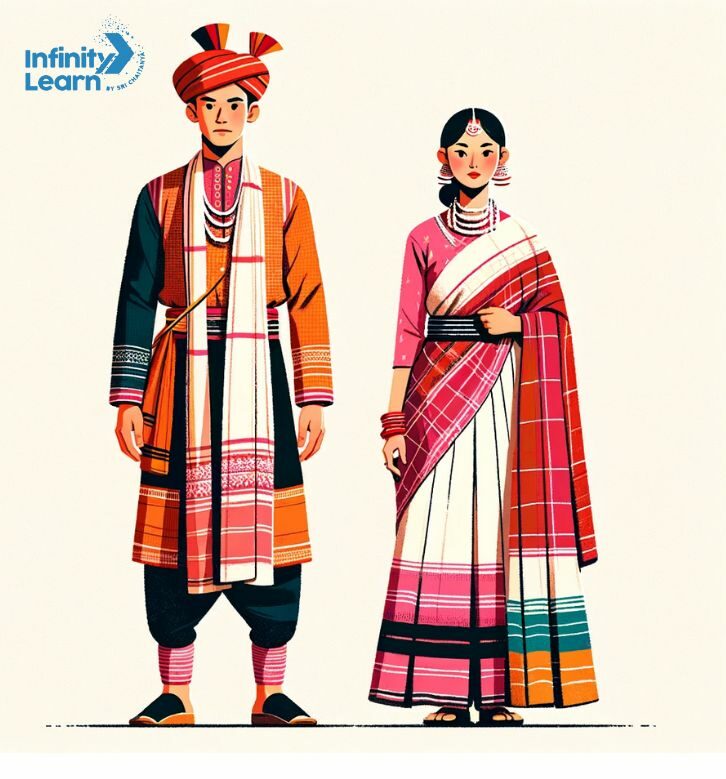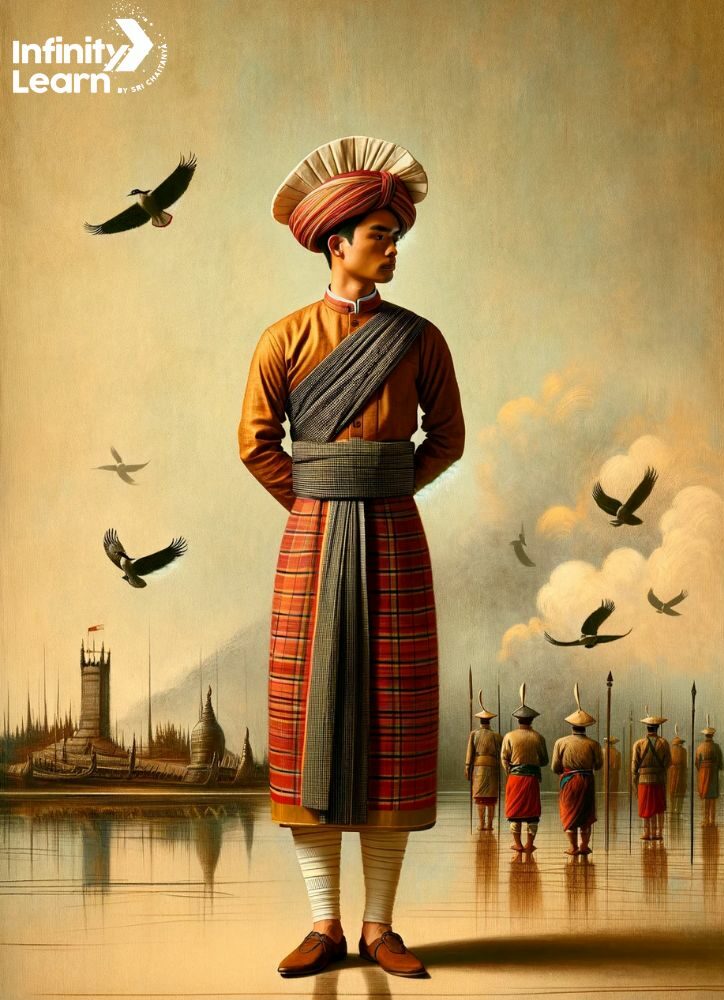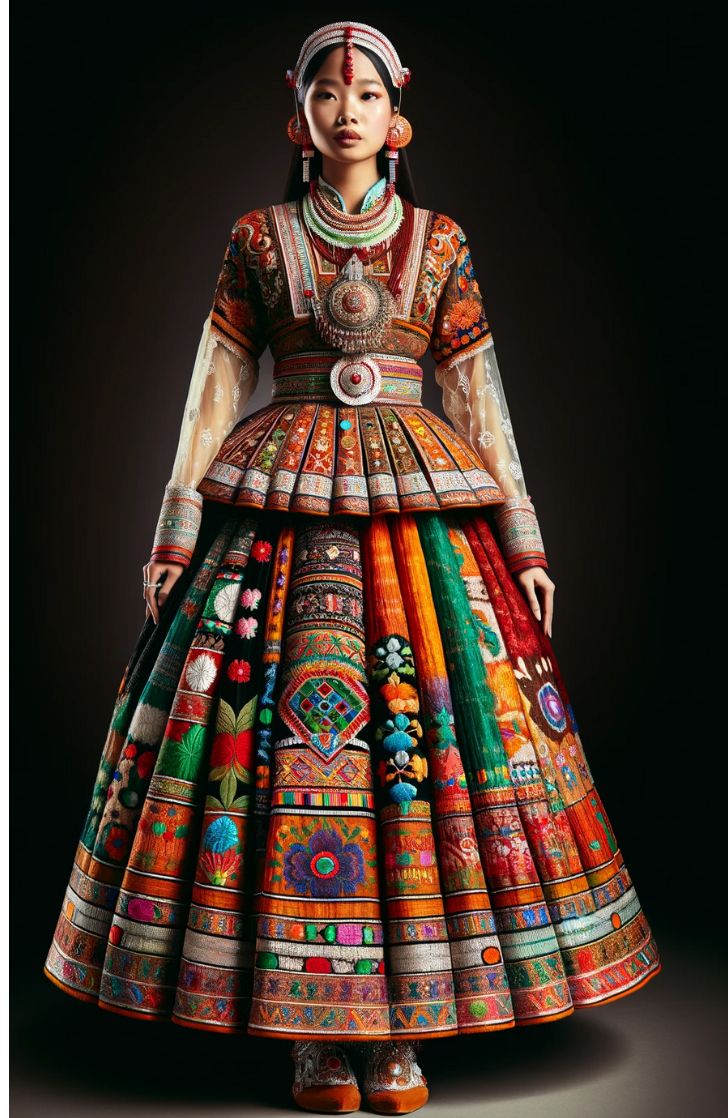Table of Contents
Overview of Manipuri Traditional Dress
The traditional dress of Manipur is well-known for its distinctiveness, grace, and appeal. These outfits are uncomplicated, understated, cozy, and fashionable, representing the rich culture and history of the area. Manipuri traditional dress not only mirrors the state’s historical and ethnic variety but also highlights the exceptional skills in craftsmanship and textile artistry that Manipur is famous for. Manipur traditional attire serves as a vivid expression of the state’s cultural values and plays a vital role in preserving the region’s heritage.
During festivals and cultural events, people from Manipur wear various types of clothing. These include the Potloi, which is a traditional outfit for the Rasa Leela festival, as well as other costumes like Koks and Phurits. These outfits are often decorated with applique work, sequins, studs, and decorative stones, making them look even more beautiful.
In modern times, Manipuri people have become more interested in fashion, mixing traditional designs with modern styles. For instance, the traditional Impanhi dress for women is now worn with a modern skirt. There are also modernized versions of traditional dresses like the Rani Phi, which use modern dyes and different patterns on the traditional cotton inaphi.
Manipuri Traditional Dress Name
The traditional dress of Manipur, a state in Northeast India, is famous for its bright colors and detailed patterns. Manipuri traditional dress name depends on whether they are worn by men or women. Below we have mentioned Manipuri traditional dress name for female and male separately:
separate
Manipuri Traditional Dress for Male Name
These area the names of Manipur traditional dress for male:
- Dhoti or Pheijom
- Kurta or Shirt
- Pagri
Manipuri Traditional Dress for Female Name
These area the names of Manipur traditional dress for female:
- Innaphi
- Phanek
- Khanep Phanek
- Lai-Phi
- Chin-Phi
- Mayek Naibi
- Potloi
- Kumjin
Manipuri Traditional Dress Images

Manipuri Traditional Dress Male
Dhoti or Pheijom
The Dhoti, also known as Pheijom in Manipur, is a traditional outfit for men that holds great cultural significance in Manipuri society. It’s a long piece of cloth, usually white or cream, wrapped around the waist and legs in a specific way. The way it’s worn can vary, but it usually reaches down to the ankles and is designed to allow for easy movement. In the culture of Manipur, the Dhoti or Pheijom isn’t just clothing; it’s a symbol of tradition and respect. People commonly wear it during important occasions like religious ceremonies, weddings, and cultural festivals. In these situations, the Dhoti represents purity, respectability, and a connection to Manipuri heritage.
Kurta or Shirt
In Manipuri culture, the “Kurta” or “Shirt” is a crucial part of men’s traditional clothing. Even though it’s a simple piece of clothing, it holds great cultural importance. The Kurta represents grace and respect in Manipuri society, going beyond just clothing. Men wear it on significant occasions like religious ceremonies, weddings, and cultural festivals, showing their respect for tradition and their involvement in the community’s cultural activities.

Pagri
The “Pagri” is an important part of traditional men’s clothing in Manipur, a state in Northeast India. It’s like a special turban that represents honor and respect in Manipuri culture. People usually wear it on formal occasions, ceremonies, and festivals. The Pagri is highly valued in Manipuri society. It’s usually made from a long piece of cloth, often in bright colors or with simple designs.
Manipuri Traditional Dress Female
Innaphi
The Innaphi is a vital part of the traditional attire for women in Manipur, a state in Northeast India. It’s like a shawl that goes over the upper body, often on top of a blouse. The Innaphi is made from different materials, like delicate silks and cotton, and it’s decorated with intricate patterns and designs that often show the rich culture of Manipur. These patterns usually come from local plants and animals, showing the strong connection between nature and the culture of the region.
Potloi
The Potloi is a special outfit worn by women in Manipur, especially during weddings and dance performances. It’s a lovely, bell-shaped skirt adorned with beads, sequins, and mirrors, creating a vibrant and attention-grabbing appearance. This attire is not just about looking pretty; it has deep cultural importance in Manipur. It represents tradition and is a significant part of Manipuri heritage, often seen in classical dances like the Ras Lila. The intricate design and bright colors of the Potloi mirror the happy atmosphere of Manipuri celebrations and its role in preserving and displaying the region’s rich cultural history. This outfit beautifully represents Manipur’s art and traditions, making it a treasured part of their cultural identity.

Phanek
Manipuri traditional dress Phanek is for women. It’s similar to a sarong and is worn around the waist, reaching down to the ankles. This clothing is unique because it’s often handcrafted with special designs that represent Manipuri culture. Women wear the Phanek in their daily lives and for important occasions like festivals and weddings. It’s not just attire; it’s a symbol of Manipuri heritage, showcasing the talent and craftsmanship of local weavers. The Phanek keeps the women of Manipur connected to their traditions and is a source of pride in their identity.
Khanep Phanek
The Khanep Phanek is a traditional outfit worn by women in Manipur, a state in Northeast India. It’s similar to a sarong and is wrapped around the waist. What makes this dress special are the handmade patterns and bright colors. Women in Manipur wear the Khanep Phanek for important occasions like festivals and weddings. It’s not just clothing; it represents Manipuri culture and heritage. The patterns on the Phanek often tell stories about local traditions and the community’s way of life. Wearing the Khanep Phanek is a way for Manipuri women to honor their culture and preserve their traditions. It’s a beautiful example of Manipur’s rich cultural heritage.
Lai-Phi
Lai-Phi” is a traditional outfit for women in Manipur, a northeastern state in India. This attire is significant to their culture, representing the rich heritage of the region. Lai-Phi is a special shawl, often worn with the traditional Phanek (a wraparound skirt) and a blouse. It’s known for its beautiful and intricate designs, usually handwoven. These designs often feature patterns inspired by nature and local stories, making each Lai-Phi unique. This dress isn’t just about looking good; it’s a symbol of Manipuri identity and is proudly worn during important occasions like festivals and weddings. The Lai-Phi highlights the skillful artistry of Manipuri weavers and their strong connection to their cultural roots.
Chin-Phi
The “Chin-Phi” is a special accessory in Manipuri clothing for women. It’s like a light scarf made from fine fabrics such as silk. Women wear it around their necks or over their heads, especially during traditional events and festivals. The Chin-Phi is more than just clothing; it’s a symbol of grace and modesty in Manipuri culture. Its use in traditional dances and ceremonies shows how important it is to preserve and celebrate Manipuri heritage. Simple in design but rich in meaning, the Chin-Phi beautifully represents the mix of function and culture in Manipuri women’s traditional clothing.
Mayek Naibi
Mayek Naibi plays a significant role in the traditional clothing of Manipuri women, especially in the Phanek, which resembles a wraparound skirt. It’s a decorative strip at the hem of the garment, usually handwoven with intricate designs and contrasting colors to the main fabric. This border is not just for looks; it carries cultural importance, symbolizing Manipur’s rich artistic heritage. Mayek Naibi reflects the skill and creativity of Manipuri weavers and is a cherished part of women’s attire, especially during important festivals and ceremonies. It proudly represents the state’s traditions and is worn with pride by Manipuri women.
Kumjin
The Kumjin is a traditional top worn by women in Manipur, a state in Northeast India. It’s a simple but stylish part of their clothing, often worn with the Phanek, a wraparound skirt. The Kumjin is well-known for its comfort and modest design, typically made from cotton or other lightweight fabrics. It’s important in their culture as it’s worn during special occasions like festivals and weddings, representing the traditions and customs of the Manipuri people. The Kumjin, with its simplicity, nicely complements the more intricate Phanek and Innaphi (a shawl-like cloth), showing the balance in Manipuri fashion between simple elegance and detailed patterns. This traditional top is a symbol of the region’s culture and heritage, cherished by the proud women who wear it.
Bishnupriya Manipuri Traditional Dress
The Bishnupriya Manipuri community, different from the Meitei Manipuris, has its own special traditional clothing that represents their culture. They are mainly found in Northeast India and parts of Bangladesh, and they keep their traditions alive through their clothes.
For Bishnupriya Manipuri women, their traditional attire consists of:
- Rigum: This is a traditional skirt that is similar to the Phanek worn by Meitei Manipuris. It comes in bright colors with unique patterns that show off the community’s weaving skills.
- Risa: This is a shawl-like piece of cloth, similar to the Innaphi, that is draped over the upper body. The Risa is usually made from fine fabric and is beautifully designed, often featuring cultural motifs and designs.
- Blouse: Along with the Rigum and Risa, women wear a simple blouse that is modest and complements the rest of the outfit.
For Bishnupriya Manipuri men, their traditional clothing includes:
- Dhoti: Like in other Manipuri communities, the dhoti is a common traditional bottom wear. It is wrapped around the waist and legs and is comfortable for various activities.
- Kurta: This is an upper garment worn with the dhoti. The style and fabric of the kurta can vary, but it usually matches the simplicity and elegance of the dhoti.
- Pagri: A turban that represents respect and honor. It is an important part of the traditional attire, especially for formal events and ceremonies.
FAQs on Manipuri Traditional Dress
What is the traditional dress of Manipur?
The traditional dress of Manipur for men includes a dhoti or Pheijom, a kurta, and a pagri (turban). For women, it includes a Phanek (wraparound skirt), an Innaphi (shawl), and sometimes a blouse called Kumjin.
What is Innaphi and Phanek dress of Manipur?
In Manipur, the Innaphi is a shawl-like cloth worn over the upper body, and the Phanek is a wraparound skirt. Both are traditional attire for Manipuri women, known for their vibrant colors and intricate designs.
What is Potloi?
Potloi is a traditional, bell-shaped skirt worn by Manipuri women during special occasions like weddings and cultural dances. It's heavily embellished and plays a key role in traditional Manipuri dance attire.
What is the name of the bride's dress in Manipuri?
In Manipuri weddings, the bride's dress is often the Potloi, which is a richly decorated, bell-shaped skirt, paired with a fine Innaphi and an elegant blouse. This attire is a symbol of festivity and tradition.
What is the meaning of Innaphi?
Innaphi in Manipur refers to a traditional shawl-like cloth worn by women. It symbolizes elegance and cultural heritage, often featuring beautiful designs and is draped over the upper part of the body.







